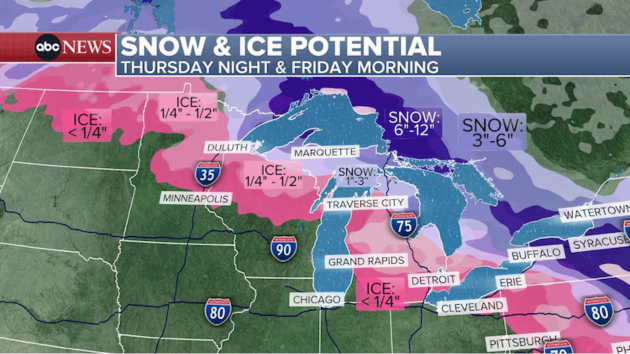This is when peak northern lights activity will occur
Written by ABC Audio All Rights Reserved on September 19, 2024

(NEW YORK) — A busy series of northern lights activity will soon come to a peak as the sun reaches its solar maximum stage in the coming months.
Several regions in the United States were treated to a multicolored light show earlier this week due to an increase in solar storm activity. The Aurora Borealis display stretched as far south as Arizona, Mississippi and Texas on Monday, images show.
The event followed other viewings in the U.S. in May and January. Opportunities to see the northern lights are expected to increase in the coming months.
How are the northern lights created?
Every 11 years, the sun’s magnetic field reaches its solar maximum, in which the number of solar flares is at its highest, according to the National Oceanic and Atmospheric Administration’s Space Weather and Prediction Center.
The northern lights occur when atoms and molecules in Earth’s atmosphere clash with a solar flare, which causes the atoms in the upper atmosphere to glow, creating a spectrum of color in the night sky.
Earth is currently approaching the peak of Solar Cycle 25, in which more sunspots with intense magnetic activity are expected, according to NOAA. Impactful space weather events are possible throughout 2024.
The current cycle is expected to peak between November 2024 and March 2026, according to NOAA. Northern lights activity will be heightened during this time, scientists say.
After the solar maximum is over, the sun’s magnetic field equalizes and returns to normal.
Where can the northern lights be seen?
The northern lights are visible — typically at the poles — as the solar flares travel through space and into Earth’s magnetic field. In the U.S., the northernmost states, such as Maine and Alaska, have the best viewing opportunities.
The lights can be seen closer to the equator depending on the strength of the geometric storms. But the further south you go, a more reddish hue is visible rather than green. This is because the curvature of the Earth causes the particles to interact higher in the atmosphere.
The Space Weather Prediction Center advises star-gazers to get away from city lights and travel to the darkest location possible for the best viewing.
Typically, within an hour or two of midnight tends to be the best time, according to NOAA.
It is notoriously hard to predict when an Aurora Borealis will occur, scientists say. Often, auroras can occur with just a 30-minute warning, according to the Michigan Technological University. Researchers typically use satellites to measure the speed and density of solar wind to forecast when conditions are favorable for the northern lights to occur.
On Thursday, the northern lights may be visible from Fairbanks to as far south as Unalakleet, Talkeetna and Tok in Alaska, according to the University of Alaska at Fairbanks, Geophysical Institute website, which tracks the phenomenon.
Intense geomagnetic storms can potentially disrupt navigation systems by interfering with radio and GPS signals, as well as electrical power networks, due to the subatomic particles that bombard the Earth, according to NOAA.
Copyright © 2024, ABC Audio. All rights reserved.
 KVSP
KVSP 





